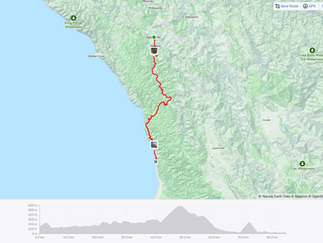Cycling the Pacific Coast: An Epic Bike Route Through Dunes, Redwoods, and Fog
- Ruth Bergman

- 14 minutes ago
- 16 min read
From San Diego Saturdays to the Open Road
The first thing we did after moving to San Diego in October 2024 was buy bikes — matching Canyon Endurace road bikes, sleek and fast, ready for the miles ahead. We joined the San Diego Bicycle Club and started showing up for their Saturday training rides — thirty-eight hilly miles that felt punishing at first. I had to learn to ride in a group, navigate traffic, and hold a steady pace among seasoned cyclists.
But within a couple of months, those rides became routine. My legs grew stronger, the climbs less daunting. And soon, my mind began to wander toward bigger horizons. The Pacific Coast Bike Route — an epic journey tracing the continent’s edge from Canada to Mexico — quickly captured my imagination.
Reality, of course, set in. Forty days on the road wasn’t in the cards. After some negotiation and careful planning, we settled on a twelve-day ride down what’s arguably the most spectacular stretch: from Florence, Oregon, to Portola Valley, California.
Twelve days, 1,100 kilometers, through dunes, redwoods, cliffs, and coastlines — a test of endurance, curiosity, and wonder.
Before the First Pedal Stroke: Routes, Bikes, Bags, Plans and Dreams
Every great ride begins with a map — or in our case, a stack of them. We bought the Pacific Coast Bike Route sections from the Adventure Cycling Association (ACA), the definitive guide for long-distance cyclists. Each map is a trove of information: detailed routes, elevation profiles, campgrounds, hotels, and small handwritten notes from those who rode before us.
We broke the journey into daily sections of 80 to 100 kilometers, balancing distance with elevation gain. The goal was to finish each day tired but not broken — ideally in a town with both hotels and restaurants, or at least one of each. It took time to make the plan, but eventually, the coast unfolded into twelve tidy stages. Oren built them all in Ride with GPS, complete with waypoints for coffee stops and photo breaks.
Originally, we planned to include California’s Lost Coast — the last undeveloped stretch of the state’s shoreline. It’s remote, rugged, and infamous for steep climbs, rough pavement, and relentless wind. But just as we were finalizing our plan, we learned about a major road closure on Highway 101 in Oregon. That meant rethinking the entire route. The lesson? Be prepared — and be prepared for surprises.
Two weeks before departure, we booked all the hotels, choosing places with reasonable cancellation policies (just in case another “surprise” arose).
For gear, we decided to ride the same bikes we’d been training on in San Diego — our Canyon Endurace road bikes. Most long-distance cyclists choose gravel or touring bikes, built for heavier loads and rougher roads, but ours were fast, familiar, and perfect for our hotel-to-hotel plan. Staying indoors each night meant we only needed to carry personal items, not camping gear, so we packed light — two small Topeak bags each, one front and one rear, with about twenty liters of total capacity.
We made one key upgrade before setting off: the most puncture-resistant tires we could find, paired with slime-filled inner tubes. Whether it was good fortune or good prep, we rode the entire 1,100 kilometers without a single flat.
The final step was flying north — which turned out to be the hardest part of all. Buying the plane tickets was easy; boxing up the bikes for the flight took an entire afternoon of careful disassembly, padding, and duct tape. At last, everything was ready — the routes mapped, the hotels booked, the bikes boxed and labeled. What had begun as a daydream over San Diego coffee rides had turned into twelve planned days tracing the Pacific edge. When we finally checked the bikes at the airport, it felt like crossing an invisible threshold: the planning was over. The ride — and whatever it might bring — was about to begin.
Wheels Down in Oregon: From Baggage Claim to Bike Lane
Our adventure seemed off to a rocky start. The flight to Eugene, Oregon, was scheduled for 3 p.m., but the moment we arrived at the airport, the dreaded “Delayed” sign appeared. As we watched the minutes stretch into hours, we began to worry that we might land too late to reach our hotel before dark. Then, just as suddenly, the gate changed—and the flight was back on its original schedule.
It turned out to be a good thing we landed on time. Reassembling the bikes in the Eugene Airport took longer than expected. Between unpacking, fitting the wheels and handlebars, and following the airport police’s instructions for how to dispose of our bike boxes, the process stretched well past an hour. Finally, around 5 p.m., we rolled the bikes to the terminal doors, clipped in, and pushed off into the Oregon air. Pulling away from an airport on bikes felt strange and wonderful—a first for both of us.
The ride into town was an easy one, perfect for a first day. The route began on a quiet country road flanked by open fields, then joined a park path that meandered toward the river. Soon we were riding along a dedicated bike trail that followed the water all the way into downtown Eugene. It was a gentle, welcoming introduction to what Oregon is famous for: thoughtful infrastructure and a culture that truly embraces cyclists. When we pulled up to our hotel, the parking attendant smiled and asked if we’d like him to valet park the bikes.
We laughed, declined, and wheeled them inside ourselves. Day one was done. We were off to a good start.
Detour into Wonder: Cycling the Oregon Dunes
The next morning, our plan was to reach the coast. Oren had found a bus from Eugene to Florence—our true starting point along the Pacific. The bus accepted bikes, but only on a first-come, first-served basis, so we arrived early, determined not to miss our ride. While waiting at the stop, we met our first fellow Pacific Coast Bike Route traveler, Garth from Seattle. Like us, he was riding to San Francisco. We would see Garth and a loose-knit group of bikepackers several times along the way, as riders’ paths naturally wove together and apart over the days ahead.
Because of the road closure that had forced us to replan the trip, we had decided to spend an extra night in Florence and explore the area on a local loop. What might have seemed a delay turned into one of the most memorable parts of the journey. The Oregon Dunes National Recreation Area stretches for more than 40 miles along the coast—a vast, shifting landscape of sand sculpted by wind and time. In places, the dunes rise like soft mountains, covered with tufts of grass and coastal shrubs, right beside the roar of the Pacific. It’s a strange and beautiful sight: a desert perched on the edge of an ocean.
We rode the quiet road along the South Jetty to the mouth of the Siuslaw River, where the dunes met the sea. The fog rolled in and out like a living thing—sometimes swallowing the horizon, sometimes parting just enough to reveal the gleam of water or the ripple of grass in the sand. When we climbed a dune, we could see layers of landscape—beach, dune, forest, fog—stacked like pages of a story.
The dunes stayed with us for the first three days of the trip, their pale shapes appearing again and again along Highway 101. But it was here, on those smaller side roads, that we felt their quiet grandeur most. If not for the road closure, we never would have come this way. Sometimes, the detours are the best part of the journey.
California Redwoods: Riding Among Giants
The Pacific Coast Bike Route is a masterclass in contrasts. Some days, the road hugs the shoreline so tightly that the spray of the waves reaches your skin. Other days, it veers inland and climbs through dark, forested mountains where the scent of pine and cedar replaces the salt of the sea. The rhythm of the ride became one of ascent and descent, sea and forest, noise and silence.
Crossing into California, the forests began to change. At first, just a hint—a solitary redwood towering above a stand of firs, a preserved giant in a coastal town park. Then, gradually, the redwoods took over. Their trunks grew wider, their crowns higher, until the forest around us felt like a cathedral built not by hands but by time.
By the time we reached Klamath—a strange little town with a grand casino and not much else—we were fully in redwood country. Over the next three days, the road led us through one grove after another, each named for a tree lover, a conservationist, or a dreamer who wanted to protect these ancient beings. We saw the “Big Tree,” and then a bigger tree, and another still. We rode with our heads tilted back, mouths open, trying to take it all in.
The Avenue of the Giants was the pinnacle—a 50-kilometer stretch of old-growth forest that felt timeless. We cycled slowly, stopping often to wander on foot among the trunks, to touch the bark that looked like sculpted bronze, to stand in the quiet hum of filtered light. Some trees had hollow trunks large enough to step inside; others had fallen long ago, their enormous root systems lying like natural monuments on the forest floor.
All forests are beautiful, but there is something transcendent about the redwoods. Their stillness humbles you. Their scale defies comprehension. And the way sunlight threads through their upper branches feels like grace itself.
The Wild Pacific Coast: Big Views, Rolling Roads
If you’ve read my blog, you know I love the sea. I kayak regularly in the Mediterranean and have paddled in waters around the world — from calm fjords to whale-rich straits. But I had never seen a sea as wild as the Pacific along this stretch of the California coast.
Around every curve, another breathtaking view revealed itself — a cove carved deep into the cliffs, with sea stacks rising like sentinels from the surf. Waves crashed and curled around their bases in endless, foaming circles. Near the shore, the ocean was alive with motion and sound; farther out, it stretched vast and silver-gray to the horizon, an expanse so wide it seemed to dissolve the edge of the world.
After three days of forest riding, we began descending toward the little coastal town of Westport. The trees still surrounded us, and then I heard it — a sharp, barking call. Could it be? Seals. I smiled at the thought: this might be the only place in the world where you can ride through a forest and still hear seals echoing from the sea below.
The California coast is a study in contrasts — rugged beauty matched by rugged effort. The road curves tightly around each cove, plunging down steep descents and climbing right back up the other side. Every roll of the road demanded strength, but also offered the perfect excuse to stop, breathe, and take in the view.
Our final day on the coast took us through Sonoma Coast State Park — a stretch of high cliffs and restless surf that couldn’t feel farther from the quiet refinement of Sonoma’s vineyards inland. It was one of our toughest days, with fierce climbs and unnerving traffic, but the scenery more than compensated: the Pacific roaring below, the wind in our faces, and the light shifting with the fog.
We rolled into Bodega Bay and looked at the birds perched on the electric lines above our motel, reminding us of the classic Hitchcock movie. We realized we were leaving the ocean behind. The coast had been magnificent, wild, and exhausting — and for the first time, we felt the trip beginning to draw to a close.
Coastal Challenges: Rain, Fog, and Crowded Roads
For ten days, we had been blessed with blue skies and calm winds. But after the Avenue of the Giants, our luck began to change. The forecast showed rain — and not just drizzle, but an all day downpour — right on the day we were to tackle our biggest climb of the trip: the long ascent from Garberville to the coast near Westport, 1,380 meters of elevation gain.
We left Garberville early, hoping to get as many dry miles as we could before the storm. The morning was gray but gentle, and by the time we reached Leggett just before noon, the rain still hadn’t arrived. We took that as a small victory, stopped at a little market for snacks, and let ourselves believe we might get lucky.
Then the first drops fell. Within minutes, drizzle turned to a downpour. We huddled under the narrow awning in front of the market, sharing the shelter with other travelers and our bikes dripping beside us. After nearly an hour of waiting, the rain showed no sign of letting up. We exchanged a look, zipped up our rain jackets, and rolled back onto the road to a chorus of good wishes — and a few incredulous smiles — from everyone watching.
The climb ahead wound through forest — narrow, twisting, and almost empty of cars. At one point, a roadwork crew waved us through as they cleared an accident. “Nice day for a bike ride!” one of them called out, half-joking, half-admiring. We laughed and pedaled on. Oddly, the rain didn’t feel so bad. The climb kept us warm, and the steady rhythm of pedaling gave me something else to focus on. The forest smelled of wet pine and earth; mist hung between the trees.
But what goes up must come down. The descent was long, steep, and slick. We rode the brakes almost the entire way, hands aching from gripping the levers, pausing often to rest and shake them out. The rain had eased to drizzle by the time we neared the coast, and soon after, the gray sky began to lighten. On a bike, you get wet fast — and you dry fast, too.
By the time we rolled into our inn at Westport, our clothes were mostly dry, our shoes still soggy, and our bikes caked in road grime. We were exhausted, filthy, and deeply content. There’s no shower quite as satisfying as the one that follows a day like that.
Later, with a beer and pizza from the local store, we wandered down a narrow path to the beach. The fog hung low, the surf murmured, and a flock of shorebirds traced patterns above the water. Tomorrow promised more rain, but for that moment, we were warm, dry, and exactly where we wanted to be.
Crossing the Golden Gate: Riding Over a Masterpiece
Crossing the Golden Gate Bridge must be a highlight for anyone riding the Pacific Coast Bicycle Route. For us, it was doubly special — both a long-awaited milestone and a symbolic finish line. After ten days and nearly a thousand kilometers, the bridge shimmered ahead like a promise: beyond it, just sixty more kilometers to our journey’s end.
We left our hotel in Mill Valley early, delighted to see a flawless blue sky. Our final morning climb began almost immediately — legs burning but spirits high. At the summit, the view stopped us in our tracks: the expanse of San Francisco Bay stretching wide and gleaming, the Bay Bridge faint in the distance, and the downtown skyline rising like a mirage. We paused to take it in, knowing this would be one of those indelible moments that stays with you long after the miles fade.
From there, the road curved and dipped along the bay toward the bridge itself. As we approached, flashes of that unmistakable red — International Orange — appeared against the unblemished sky. Even though we’d both crossed it many times before, by car and on foot, approaching it on bikes felt entirely different. It was intimate, human-paced — we could feel the wind, smell the salt air, hear the hum of tires on the metal grating.
Before rolling onto the bridge, we paused for photos, naturally. A high school student recognized Oren’s MIT jersey and stopped him for a chat about engineering and dreams — a serendipitous reminder of how journeys spark connections. Then, at last, we pedaled onto the bridge itself.
The crossing was pure exhilaration. The Pacific lay to our right, endlessly blue-gray and alive with wind and spray; to our right, the city unfurled in golden light, the familiar skyline suddenly new from this vantage. Traffic roared beside us, yet somehow we felt suspended above it all — part of something larger, both grand and fleeting.
We lingered far longer than necessary, stopping often to take pictures and simply to breathe it in. Afterward, we found a less-traveled viewpoint just beyond the bridge, where we turned to look back one last time. The bridge stood there, immense yet delicate, its towers gleaming against the sky — connecting not just two shores, but every mile we’d ridden to reach it.
It was the slowest couple of kilometers of our entire trip — and easily the most unforgettable.
Stops Along the Way: Hotels, Meals, and Small Joys
Long-distance cycling isn’t just about the big climbs and sweeping views — it’s also about the small rituals that give each day its rhythm. For us, that meant coffee. Every day began (and often continued) with a search for good espresso and a cozy spot to rest our legs. To our delight, the Pacific Coast delivered: from riverside cafés to oceanfront lodges, we rarely had to go far to find an excellent cappuccino and a friendly smile.
River Roasters in Florence was an early favorite — a cheerful spot perched on the Siuslaw River, serving strong coffee and fresh pastries with a view of fishing boats drifting by. A little farther south, Bandon Coffee Café charmed us with its bagels and small-town warmth, perfectly matching the easygoing pace of this coastal village.
Crossing into California, Paragon Coffeehouse in Crescent City stood out for its flawless cappuccino and unpretentious atmosphere. But if we had to choose a single winner, it might be GoodLife Café & Bakery in Mendocino — home to the best cappuccino of the trip and a morning bun delicately scented with citrus and cardamom. From there, the cafés became as memorable for their settings as for their coffee: The Café at Sea Ranch Lodge, with its ocean views, and Café Aquatica, perched beside the Russian River in Jenner, where we lingered over steaming mugs as pelicans glided by.
Meals were another daily joy — small celebrations of reaching the next town. Breakfast at Portside Market and Café in Port Orford deserves special mention: hearty, perfectly cooked, and served with a smile that made us feel instantly at home.
And of course, there was BJ’s Ice Cream Parlor in Florence, which delighted our Boston-honed ice cream sensibilities. The old-timey sign, creamy textures, and nostalgic charm made it one of those simple pleasures you don’t plan for but never forget.
After the miles were done, hotels became sanctuaries. Castaway by the Sea in Port Orford offered perhaps the most beautiful setting of the trip — a modest inn overlooking the harbor, where we watched the light fade over the cove. Wharf Master’s Inn in Point Arena had an idyllic setting at the fishing pier, an overpriced room, and — to its credit — the best hotel breakfast of the trip. Farther north, two classics stood out: Hotel Arcata, with its old-world charm right on the town square, and Scotia Lodge, steeped in the character of its historic company town and warm hospitality.
In the end, these stops — the coffee shops, the inns, the unexpected kindnesses — are what stitched the journey together. They turned the Pacific Coast from a route on a map into a living, breathing adventure.
Coastal Characters: Locals, Nomads, and Fellow Cyclists
From our very first day in Oregon, we were struck by how kind and open people were. Every interaction — from checking into hotels to ordering coffee — felt easy and genuine. Locals went out of their way to accommodate our bikes, offer directions, or simply ask about our journey. Their curiosity surprised me. Given how well-known the Pacific Coast Bicycle Route is, I expected cyclists like us to be a familiar sight. Yet everywhere we went, people wanted to know more: Where did you start? How far are you going? How do you plan your days? It was heartwarming to see how much interest a pair of travelers on bikes could generate.
But it wasn’t just the locals who made an impression. The most memorable encounters were with fellow wanderers — people whose journeys made ours seem small in comparison.
In Florence, we met Rick, a soft-spoken, sun-browned rider staying at our hotel. Like us, he was heading to San Francisco — but for him, it was the final leg of a yearlong odyssey. He had left San Francisco the previous September, ridden clear across the United States, up the East Coast, and back again. Twelve thousand miles in total. He’d replaced every single part on his bike at least once, and his stories — wild weather, endless climbs, the kindness of strangers — made our 650-mile adventure feel almost modest.
A few days later, while we waited out the rain in Leggett, we met Carl, a caravan nomad who had sold his house in Phoenix to live on the road full-time. His camper carried both a bike and a kayak — “so I can go anywhere and do anything,” he said proudly. He radiated contentment, chatting nonstop about freedom, the open road, and the joy of a simple life untethered to any one place.
And then there were our fellow cyclists — the faces that became familiar as we leapfrogged our way south. We first met Garth from Seattle at the Eugene bus stop before our very first ride to the coast. We saw him again days later, now joined by a motley crew of bikepackers from all over — including one rider from China, another from the East Coast — each headed to a different destination but traveling together for a few shared miles. Then there was “Goldilocks,” as we called him — a young cyclist with a cascade of golden curls who we kept passing (and being passed by) from Crescent City all the way to Point Reyes Station.
We didn’t form lasting friendships — everyone was on their own journey, after all — but these brief encounters added color and camaraderie to our days. Trading route tips, gear stories, and weather updates became part of the rhythm of the road. Together, these locals, nomads, and fellow cyclists reminded us that adventure isn’t just about the miles behind you — it’s about the people who share the road, even if only for a moment.
Strength, Wonder, and the Road: Reflections on Our Toughest Adventure
Of all our adventures, this was the hardest — physically, without question. Every day demanded effort: the climbs, the miles, the hours in the saddle. On other trips, I’ve reached the end wishing it could last a little longer. This time, I was ready to stop. I’ve been asking myself why that is.
Part of it, I think, was the traffic — the constant awareness, the edge of vigilance that never quite lets you relax. But it was also the sheer scale of it all. The days were long, the distances real, and the effort unrelenting. Yet within that challenge were moments of pure wonder: the redwoods rising like cathedrals, the dunes shifting in the fog, the sea stacks standing guard over the Pacific. The deer that appeared silently on the roadside. The steady rhythm of pedaling uphill, when strength becomes something you find rather than something you have.
There’s a strange alchemy that happens on journeys like this. The struggle doesn’t diminish the beauty — it deepens it. By the time we reached San Francisco Bay, the city shimmering across the water beneath a moody sky, I felt both exhaustion and gratitude.
Every adventure leaves a mark. This one left muscle and memory, grit and grace — and a renewed sense of wonder for the vast, wild edge of the continent and the simple act of traveling it under your own power.
Route Maps and Details
Our complete itinerary and daily route maps
Date | City | Distance (km) | Ascent (m) | Hotel |
Sep 18 | Eugene Airport | 22 | The Graduate by Hilton | |
Sep19 | Florence, OR | Lighthouse Inn | ||
Sep 20 | Coos Bay | 80 | 737 | Quality Inn & Suites |
Sep 21 | Coos Bay | |||
Sep 22 | Port Orford | 89 | 826 | Castaway by the sea |
23 | Brookings | 92 | 1215 | Westward Inn |
24 | Klamath | 83.7 | 775 | Holiday Inn Express Klamath - Redwood Ntl Park Area |
25 | Arcata | 90 | 915 | Hotel Arcata |
26 | Scotia | 73.2 | 492 | Scotia Lodge |
27 | Garberville | 72 | 717 | Best Western Hamboldt House Inn |
28 | Garberville | |||
29 | Westport | 83.5 | 1380 | Lost Coast Vista Inn |
30 | Point Arena | 98 | 1200 | Wharf Master's Inn |
Oct 1 | Bodega Bay | 101 | 1331 | Bodega Harbor Inn |
2 | Mill Valley / Sausalito | 100 | 1026 | Holiday Inn Express |
Oct 3 | Portola Valley | 72.5 | 783 | Schonfeld Residence |
Packing List
Cycling Clothes & Accessories
2 kits
2 shirt liners

Leggings
Arm warmers
Bike wind/rain breaker
Warm bike jacket
Rain booties
Bike gloves, short and long
2 bike socks
2 jog bras
Sunglasses
Bike helmet
Bike shoes
Watch
After Bike Clothes
Warm socks
Crocks
2 underwear
Sleeping shirt
Long/warm shirt
Long pants
2 T-shirts
Long John
Bathing suits
Rain jacket
Tech
Phone
Bun o
iPods
Chargers
Personal items
Toothbrush
Toothpaste
Butt butter
Sunscreen
2 Lip balm
3 Bars
Shaving
First aid kit
Bike Gear & Tools
Front and read bike bags
Bike lock
2 inner tubes
Bike tool, electric pump, 4 CO2 Cartridges, Torque wrench
Resources
San Diego Bicycle Club, https://sdbc.org/
Adventure Cycling Association, https://www.adventurecycling.org/routes-and-maps/adventure-cycling-route-network/pacific-coast/
Ride with GPS, https://ridewithgps.com/



































































































Comments